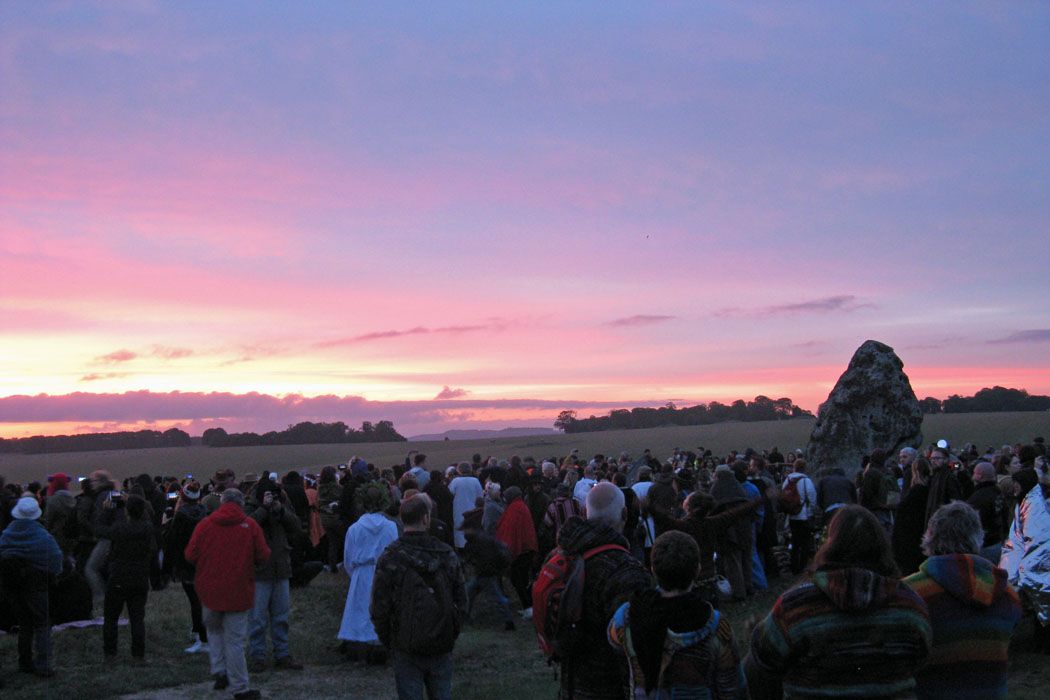Americans, Bicycles and Clouds: reporting the summer solstice at Stonehenge
The perennial media interest in the summer solstice gathering at Stonehenge led me to wonder how the press reported it in the past; indeed what early newspaper reports might tell us about the origins of the modern event. This is the result, or part of it at least - covering the period up to and around the turn of the 20th century. It is not a social history of the solstice but the reports are full of interesting details and often surprisingly evocative.
__
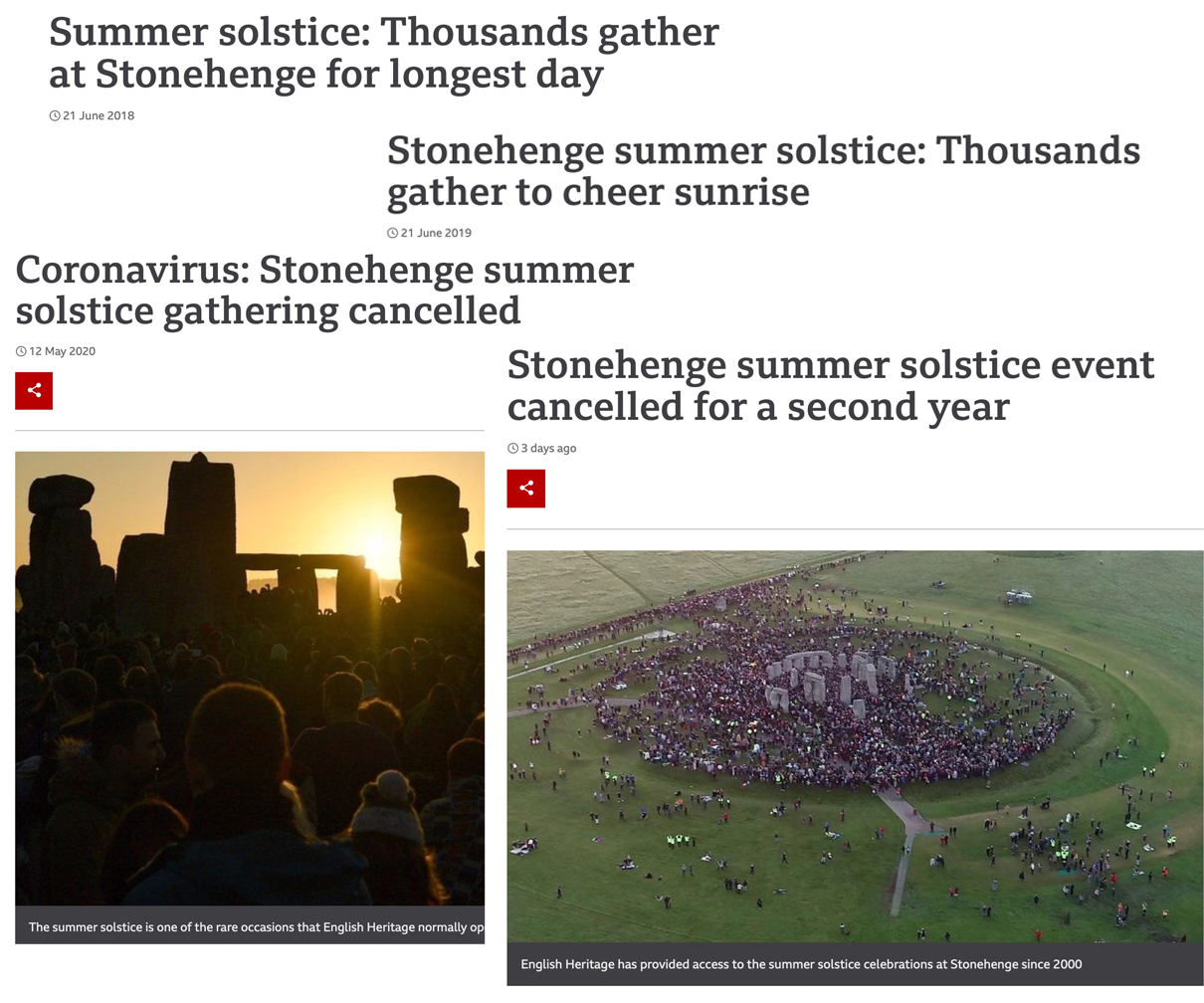
In July 1874 The Scotsman reported on "A remarkable spectacle that was witnessed on Midsummer’s morning at Stonehenge" by a party of American tourists. The correspondent was "not aware that in any work on these megalithic circles is reference made, however remotely, to what I am now about to mention." This of course was the rising of the sun over "one solitary stone in a sloping position" (the Heel stone) when viewed from "the stone table or altar … within the circle directly looking down the avenue", such that it "appeared actually to rest on the isolated stone … or to quote the quaint though prosaic description of one present, ‘it was like a huge pudding placed on the top of the stone!’"
__
However, this alignment was certainly not unknown to the locals. The Scotsman's report mentions that the Americans were "not a little surprised to find that, instead of having the field all to themselves, as they had expected, a number of people from all parts of the countryside, principally belonging to the poorer classes [my emphasis], were already assembled on the spot" because a tradition "told them that at Stonehenge something unusual was to be seen at sunrise on the morning of the summer solstice."
__
While, courtesy of the American visitors, the national papers may have noticed what was going on for the first time, the idea that no-one had made reference to the solstice sunrise before was simply wrong. Only the year before, on 20 June 1873, The Globe had a front-page article reporting that "For several years visitors from the neighbourhood, as well as from distant parts, have assembled at the Circles of Stonehenge at three o'clock on the morning of June 21, weather permitting, to watch for the rising of the sun", also quoting "a gentleman who has several times been one of the early watchers on this day", who described "how the sun comes up over the pointer" (Heel stone). That year, however, as the Devizes Advertiser reported, "about 100 watchers, some in vehicles, and others on foot, assembled within the circles... but they were doomed to disappointment as... the sun was not visible at the time of its rising." The quotations of the gentleman in fact came from a letter to the Times the previous June, written by William Beck of Stamford Hill. In 1872 Mr. Beck reported that some 35 watchers were in attendance, including four Londoners who had walked overnight from Salisbury. His letter was also quoted in an article titled 'Stonehenge: what it is, and what it is not' in Charles Dickens' weekly magazine All The Year Round in Aug 1872.
__
That appears to be the earliest press mention of a solstice gathering, but when did the custome actually begin? In 1865 the Devizes and Wiltshire Gazette reported on "a paper by Mr Cunnington of Devizes", read at the Wilts Archaeological Society, in which he said "our friend Dr Thurnam will show you tomorrow an isolated unhewn stone in the avenue … over which the sun is said to rise at the summer Solstice. His devotion to science … induced him to test the truth of this, and at Midsummer, 1858, he watched the rising of the sun from the altar, when it was seen to rise precisely over this stone. Mr Purser, of Dublin, also verified the same fact some years ago."
__
It seems odd that the idea was not widely known before the 1870s as there are some big names mentioned here: William Cunnington (1813-1906), the grandson of the more famous William who worked with Colt Hoare; John Thurnam (1810-1873; below left), well known for his archaeological (and craniometric) work but also at this time superintendent of the Wiltshire county asylum at Devizes; and John Purser (1835-1903; below right), a mathematician who though born in Dublin had been educated in Devizes.
__
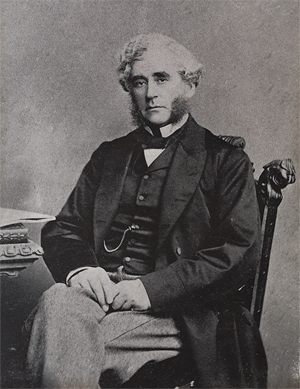
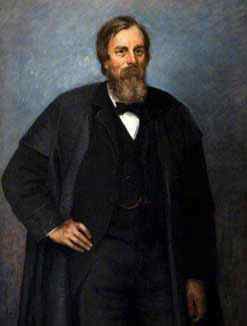
__
While The Scotsman noticed the poorer classes, for those less poor the solstice remained a scientific opportunity. In 1874 The Scotsman’s correspondent returned to the theme, since interest in the earlier report had led an (unnamed) "party of civil engineers" to spend "four or five days measuring the structure and making astronomical calculations", the results of "perhaps the most important if not only scientific survey in the true sense of the term that has been made of these historic ruins" leaving "not the least doubt about the solar references of the structure". A book was promised...
__
Whether such a book appeared is uncertain, but this was around the time that Flinders Petrie (1853-1942; below) conducted his archaeological survey of Stonehenge (Stonehenge: plans, descriptions and theories, published in 1880, although the work was carried out in 1874 and 1877). Petrie also noted "The large numbers of people that keep up with much energy the custom of seeing the sun rise at midsummer" and states that the "popular idea of the sun rising on the longest day behind the Friar's Heel [Heel stone] … was carefully tested by theodolite observations". However he concludes that although "the sun rose over the peak of the Heel stone at 730 AD" it would not have done so at the date Stonehenge was constructed. Nonetheless, attempts to use astronomical observations to estimate what that date might have been would continue, as we shall see.
__
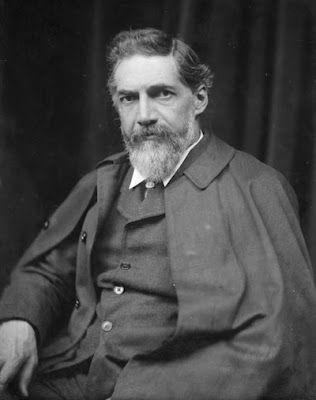
__
After 1875, press interest in the solstice events seems to have waned somewhat, though the gatherings clearly continued; perhaps there was simply a lack of interest in what the country folk did. In 1879 the Dorset County Chronicle reported that at least 200 people were present, although:
"The great big sun they couldn’t see
Because it wasn’t there."
Nevertheless the crowd amused themselves by dancing to concertinas "with much zest" before the rain drove them away.
__
In 1882, the Hampshire Advertiser reported a gathering of around 300, although as the Salisbury Times and South Wilts Gazette put it, once again "the crowded and now threatening mass of clouds showed little disposition to allow Sol’s face to be seen". More significant for the future was the first mention of the presence of "the bicyclist, half-humorous in the consciousness of the excellence of his machine…".
__
There were also further scientific visitors on the midsummer solstice, including in 1887 and 1893 Dr J Lardner Green of Salisbury - another attempting to determine the date of Stonehenge through observation of alignments - who was accompanied on the latter occasion by a professional photographer. Unfortunately, according to the Isle of Man Times (reporting a lecture by Dr Haviland to the Manx Astronomical Society), "a north wind sprang up, bringing a sort of blight over the Avon Valley" so that at sunrise no sun was visible on the horizon.
__
Local societies were certainly learning about the solstice. In 1894 the Swindon Advertiser reported a lecture by Rev EH Goddard, then editor of the Wiltshire Archaeological Magazine, to the Wootton Bassett Mutual Improvement Society, in which he "alluded to the annual visit, on Midsummer day, by people in large numbers, to view the rising of the sun." And press coverage of the celebrations also increased during the 1890s, although the numbers present varied. In 1894 the Salisbury and Winchester Journal reported that although visitors to Stonehenge on midsummer morning "were fortunate enough to see the sun shine at rising on the altar stone… There were very few persons present, the principal spectators being a brake-load of boys from Marlborough College". The following year, however, according to the Wiltshire Times, around 400 people, including "perhaps, fifty" ladies, witnessed a "beautiful sunrise"; there were 60 to 70 horses near the stones and "about one hundred cycles were scattered about the ruins."
__
In 1896, numbers continued to grow and the Salisbury and Winchester Journal said the midsummer gathering was unusually large: "it may be doubted, indeed, whether such an assembly has collected there to watch the rising of the midsummer sun since the far-off times when the rites of sun worship were practised in the famous temple". The description is worth reproducing:
__
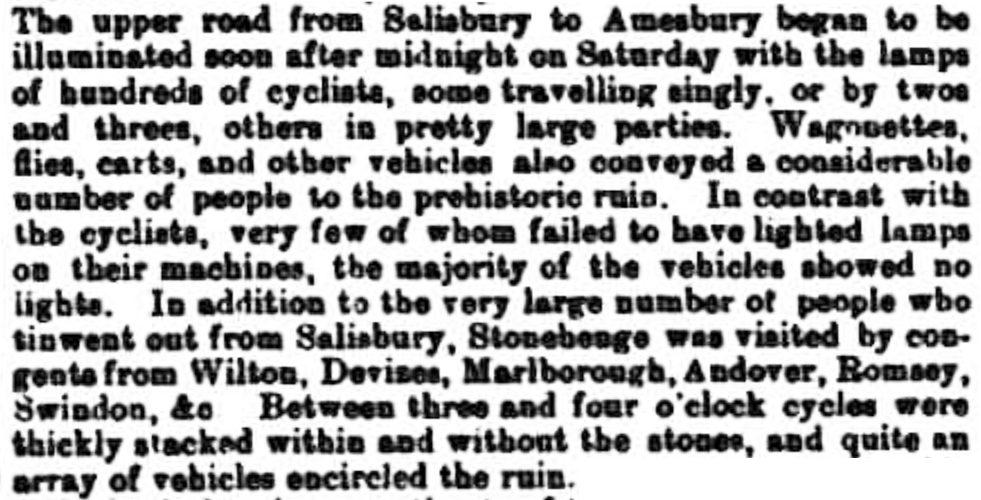
__
In all the paper estimates 1500-2000 people were present, reflecting the fine weather, the fact it was a Sunday, "and the recent extraordinary development of cycling". Unfortunately, however, clouds appeared at just the wrong moment" though the crowd apparently took the disappointment well. The report concludes by noting that "a few policemen were present to keep order" though there was little trouble, "with the exception of some rough lads and boys, who indulged in horseplay and in the very objectionable practice of smashing against the stones the empty bottles, of which too many were left lying about". The Cheltenham Examiner describes "A mass of human beings on the altar stone at the point of vantage … and a line of about ten deep all the way from the altar stone to the pointing stone" and also finds newsworthy the presence of "several Americans [who] had come over for the event".
__
Two years later a much briefer report in the Salisbury and Winchester Journal stated that "A good number of persons assembled" but the morning was again cloudy. In 1899 ‘Our Special Cyclist’ wrote a lengthy piece for the Daily News describing how "the roads converging on Stonehenge are thronged with pilgrims from near and far" every year, even though it had been 12 years since anyone had seen the sun rise on the longest day (unfortunately that year was no exception). There was even a special if rather specific licensing exemption:
__

__
However, the years of poor weather may have had some effect: "instead of the four thousand pilgrims who generally come to pay their devoirs to the sun on this occasion, fewer than a quarter were gathered". Cycling magazine printed a photo of Stonehenge "As it was at 3.45 am, June 21st" and a drawing of "As it should be". The crowd’s behaviour was also commented on: "It is not to be supposed that it was a reverent crowd. Reverence is not a characteristic of the age…". The Leeds Times adds the detail that "A party of musicians discoursed popular melodies" while a surprisingly poetic policeman described the previous times he had managed to see the sun: "He said the stone was surmounted by a circle of golden light, crowned by a halo of varied colours, terminating in long shafts of shadow". The Daily News correspondent concluded that "There would seem to be something dashing and eccentric about such a proceeding" to attract people with no interest in archaeology.
__
The weather was even worse in 1900 when the Warminster and Westbury Journal reported that "Despite the dampness and dullness and general misery which characterised the weather … it didn’t deter the usual large number of people [about 200, according to the Salisbury and Winchester Journal] from doing themselves the injustice [my emphasis] of getting up before going to bed on that day and cycling or driving to Stonehenge". As this suggests, the turn of the century saw a change in tone of the reporting, with some of the press becoming rather scornful of, or at least poking fun at, the solstice gathering: "It is the same sun they can see any day at home, the same stone to be witnessed at Stonehenge any time…".
__
Similar comments appeared when the London papers began to pick up on the event. A couple of weeks later in 1900 the Warminster and Westbury Journal included a report on ‘How a London Pressman saw Stonehenge’, or rather what one (unnamed) London paper thought about the purple prose of a story in the Daily Mail ("a most interesting paper, and no asylum should be without it" - some things don’t change…) describing a visit to Stonehenge on midsummer morning, including strong opinions about cyclists:
__
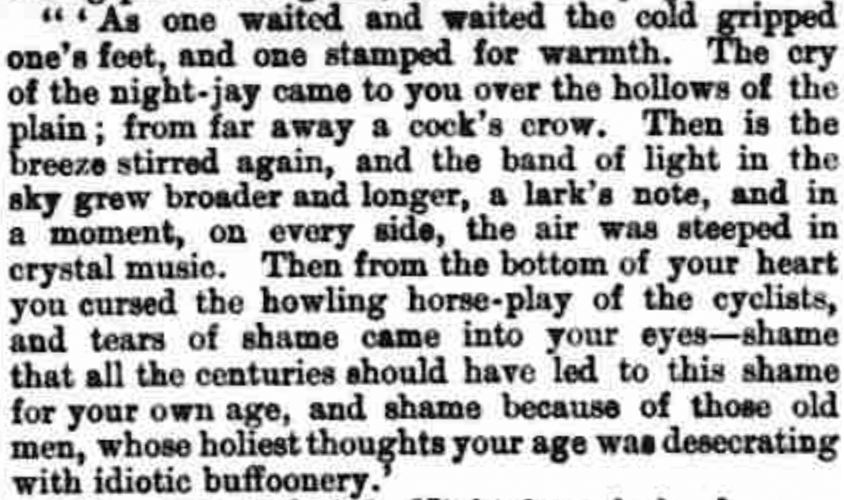
__
In 1901 the Daily Telegraph wrote, probably with tongue in cheek, that "Today there will be some very unpleasant persons in the neighbourhood of Stonehenge … ‘so proud all the morning and so tired and cross all the afternoon’ that their society will be ungenial", though the main problem was the recent poor weather ("ladies have visited Ascot in furs") which meant the name ‘Midsummer Day’ "can only be regarded as humour of a mild but irritating character". In fact, as the Wiltshire Times reported, the attendance that year was small because for the first time "The modern girdle of barbed wire together with the turnstile keeper’s hut" meant people had to pay for admission. About 50 did so with around 30 more present outside: "One looked around in vain for the parties of merry-makers which hitherto have visited the Plain with wonderful regularity…" while as for the police presence, "the reason for such a posse of ‘men in blue’ was almost as mysterious as the origin of the stones round which they kept tramping." The weather did not improve: "though a skilled astronomer was on the spot, observations could hardly have been taken".
__
The Wiltshire Times correspondent commented that the means by which the astronomers hoped to determine the age of Stonehenge "is not for the ordinary mortal to say". However, a couple of weeks later The Sphere did its best to explain in a full page illustrated spread reporting on the measurements taken by "Mr. Howard Payn, who is well known in connection with the Solar Physics Laboratory, South Kensington." Although the weather prevented any measurements on 21 June, four days later "Mr Payn successfully took the position of the rising sun, the difference between the few days being easily allowed for."
__
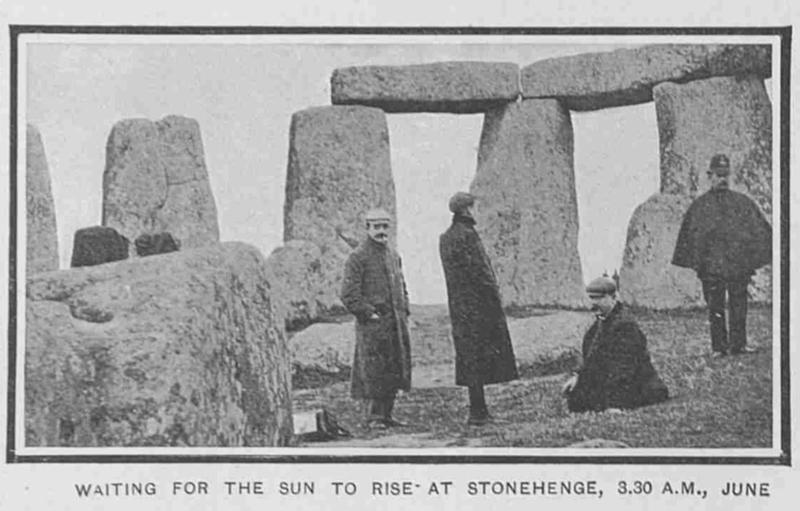
__
The results were published later that year in a paper by Sir Norman Lockyer and FC Penrose entitled 'An attempt to ascertain the date of the original construction of Stonehenge from its orientation’ (Proceedings of the Royal Society of London, vol. 69). However, the method did not meet universal approval. In 1903, as The Globe reported, Mr AR Hinks of the Cambridge Observatory pointed out "the grave difficulty that everything depends upon guessing aright what is to be considered the critical phase of sunrise or sunset" and "it is doubtful whether anything is gained by these attempts to help out the deficiencies of archaeology by the aid of astronomy."
__
Returning to the event itself, also in 1903 the St James’s Gazette found it "rather difficult to account for the superfluous energy which impelled a number of enthusiasts to welcome the rising of the sun directly over the altar stone at Stonehenge", especially given the continuing issues of access: "the fact remains that there was quite a crowd outside, if not inside the barbed-wire entanglements of the Druidical temple". The Gazette wondered if they "have gone on their dubious pilgrimage from mere idle curiosity, or from archaeological enthusiasm, or from the motives of the ordinary beanfeaster." Anyway, it was a good day to be there as "The sunrise was a clear and beautiful one." In 1905, however, the Gloucester Citizen reported "the smallest assembly which had ever watched for the sun to rise over Stonehenge on the longest day". The gathering included some of our recurring characters, "a few scientists and American visitors, but the sun was obscured by clouds" once more.
__
But let’s end instead with Walter Barnett, who filled a whole page of The Bournemouth Graphic on 19 June 1902 with "A recollection of the twenty-first of June" (the year is not specified), which had clearly been an exciting occasion, not least judging by the number of exclamation marks he employs:
__
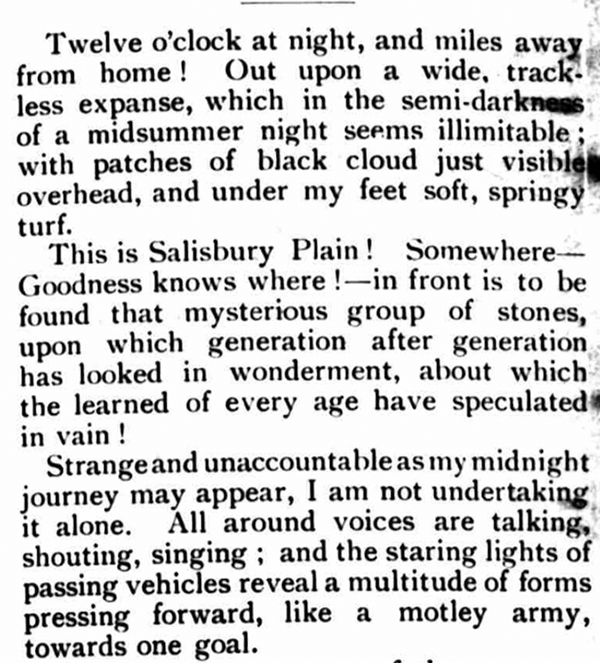
__
Our writer meets "a weather-beaten old man" who offers a gloomy weather forecast, and then tells a version of the story of the Friar’s Heel. Finally, at dawn "The singing and dancing which have whiled away the night have ceased … and every eye is strained to catch the first glimpse of dawn." The old man’s pessimism is misplaced:
__
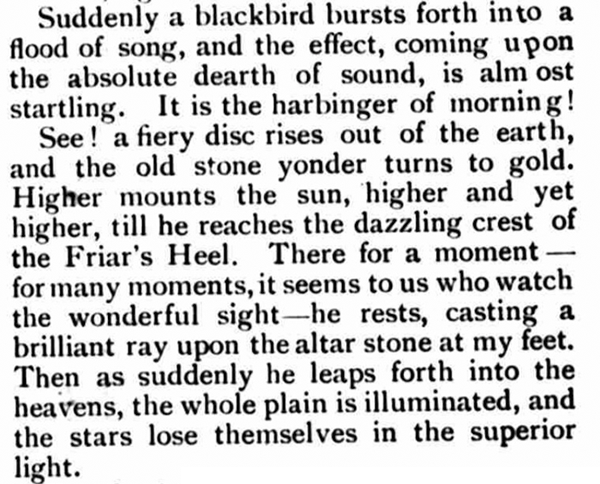
__
Although it rains later on and Barnett gets soaked, he concludes "What does it matter? I have had my sight. I have seen what everyone should see once - SUNRISE AT STONEHENGE." 120 years on, it’s hard to disagree… This is my photo from 2015. A shame there are no crowds this year but happy solstice nonetheless!
__
